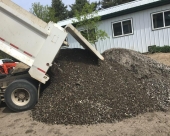VISIBILITY and
SAFETY
I have been riding as my main form of transportation since 2007, and have owned a heavy electric bike, and now am very happy with a light e-bike kit conversion. Being seen is being safe, and I have not had a road accident yet. Here is what I think keeps me safe:
1. My LED reflective vest from Maxsa Innovations:
https://www.maxsainnovations.com/reflective-safety-vest-with-16-led-lights/. Currently available on eBay for $21 including shipping. ( I never buy from Amazon). The lights are on the sides, as well as the front and back. I ride with them flashing, and several times over the years cars have pulled over or stopped on the road and the driver has thanked me for wearing it, and wished all cyclists would wear one. Runs on 2 AA batteries, and lasts a long time if you don't stuff it into a bag and break the wires. I wear this vest on every ride. Wearing it during the day comes in handy if I need to stop and get some obstruction off the road (most often a dead animal, but sometimes a big branch, or something that fell off a truck. It looks so official, you see, and motorists see me.
2. My flash flag, 18 inch long that sticks out into traffic, and really keeps the cars a safe distance away. Even an inch or two helps a lot! The wonderful former Canadian Mountie, Terry Smith, who created and sold these has retired, and no one has picked up the business. I bought a bunch of them when he was closing down, so should have a lifetime supply now. $30 on eBay right now, including shipping. This flag has a clip and a spring so you can easily bend it out of the way and clip it to your bike frame when riding on a trail, or walking it on a sidewalk, or bringing the bike in and out of a building. I know it works to keep me safe because some days I forget to unclip the flag, and wonder why the cars are coming so close to me all of a sudden. Then I realize my flag is not out there helping them to keep their distance! Here is Terry's valuable guidance to being safe after sunset:
http://www.safetyaftersunset.com
3. My mirror: I have tried many mirrors over the years. The handlebar mirrors get smashed when the bike falls over. The helmet mirrors vibrate too much, they are too small, and they need constant adjusting as my helmet shifts on my head. I am delighted to report that I have found my best mirror yet: The Bell SMARTVIEW 300 UNIVERSAL WIDE ANGLE BIKE / BICYCLE MIRROR • FULLY ADJUSTABLE. Available right now on eBay for $20, including shipping. I love being able to glance down any time and see what is going on behind me.
4. My helmet, with attachment options for front and rear lights. I first saw a helmet like this in Portland, Oregon, and loved how the cyclists were more visible with that back light so high up, so I bought one. When riding at night, I love having both a light on the front of my helmet, and a second one on the handlebars. My helmet light lets me see what obstacles might be in the way on the side of the shoulder, and further ahead. I can even use it to help drivers realize they should dim their headlights to keep from blinding me. The Blackburn Flea lights that came with the helmet are no longer being made, but there are other lights out there now that can be attached to a helmet.
5. Riding without sunglasses. I make firm eye contact with drivers who are about to pull out into the road, so they know I am there, or at intersections, etc. Even then, sometimes they pull out anyway. That seems to happen in the mornings, when people are heading to work and are totally on auto pilot.
6. I never, ever ride with earphones. I want to hear what is going on around me at all times.
7. My small wind chimes. A friend gave me a small set of wind chimes (metal, 3-4 inches long), in 2008, when I was living a nomadic life, and only had my tent and bike. I couldn't hang them on my round tent, so I put them on my bike. They are still there, and have saved me at least once from being 'doored'. I was riding along a row of parked cars on a busy street in the summer, and just after I passed a car a man called out to me: "Hey, I almost opened my door into you, but I heard your wind chimes!" Wow. They also help me avoid accidents with pedestrians up ahead of me, when riding on a path or on a shared road shoulder, because they can hear me coming. When riding with other cyclists, they can hear if I am still with them. The sound is gentle, pleasant, and always there.
8. Turn signals. I just bought these, and have only used them once, so can't really say how well they are at keeping me safe. But I need to make a left hand turn onto my street, from the 50mph curvy highway near my home, and drivers can't see my arm sticking out there at night if I am sitting stopped on the highway waiting for a chance to turn left. I always breathe a sigh of relief when I make that turn safely - day or night.








